Playing With The Glowstick Reaction Using TCPO (bis(2,4,6-trichlorophenyl) Oxalate).
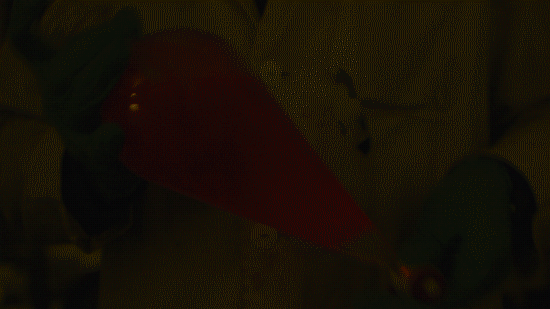
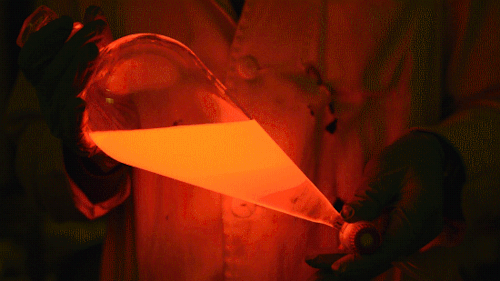
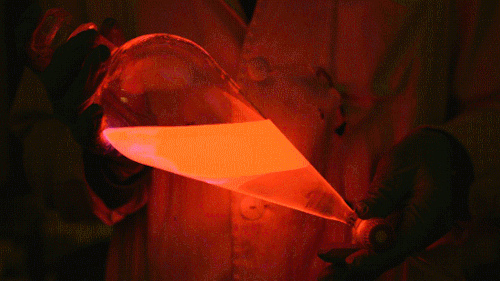
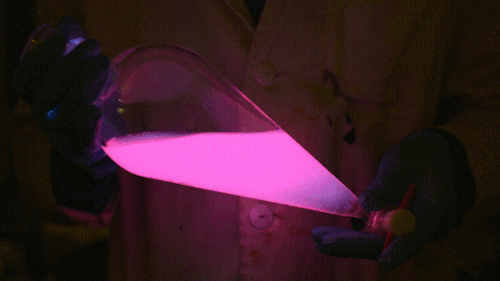
Playing with the glowstick reaction using TCPO (bis(2,4,6-trichlorophenyl) oxalate).
The glow stick contains two chemicals and a suitable dye. One of the chemicals is a diaryl oxalate (in this case TCPO, or bis(2,4,6-trichlorophenyl) oxalate), the other one is an oxidizer, usually hydrogen peroxide. By mixing the peroxide with the oxalate ester, a chemical reaction takes place, releasing energy that excites the dye, which then relaxes by releasing a photon, emitting light. The color of the emitted light depends on the structure of the dye. The chemistry behind the reaction is something like this:

During this reaction I used two type of dyes, on of them was Nile Red, what is a quite special, solvatofluorescent dye and Perylene what is a polyaromatic hydrocarbon. When used in pure form the perylene emits a bright blue light, but when its combined with Nile Red, it emits this nice pinkish-purple as seen on the gifs above and on this video:
More Posts from The-sleepy-chemist and Others
Blood Vessels, part 1 - Form and Function By CrashCourse
Now that we’ve discussed blood, we’re beginning our look at how it gets around your body. Today Hank explains your blood vessels and their basic three-layer structure of your blood vessels. We’re also going over how those structures differ slightly in different types of vessels. We will also follow the flow of blood from your heart to capillaries in your right thumb, and all the way back to your heart again. Table of Contents The Basice Three-Layer Structure of Your Blood Vessels 2:17 Different Types of Vessels 3:36 The Flow of Blood From Your Heart to Capillaries 3:59 The Flow From Capillaries to the Heart 7:01
How Smells Trigger Memories By SciShow
SciShow explains how smells can bring back early memories – even memories that your brain didn’t know you had.
Hosted by: Hank Green




Cyanea capillata by Alexander Semenov

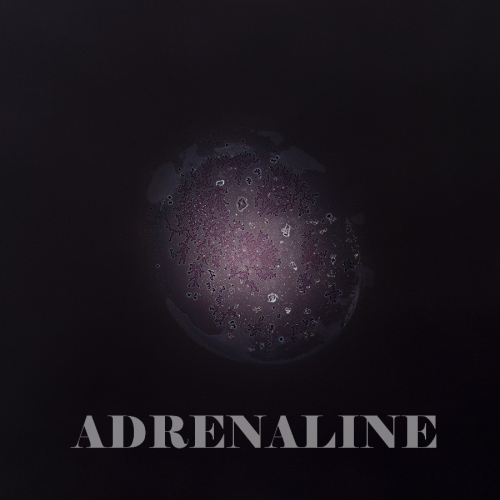
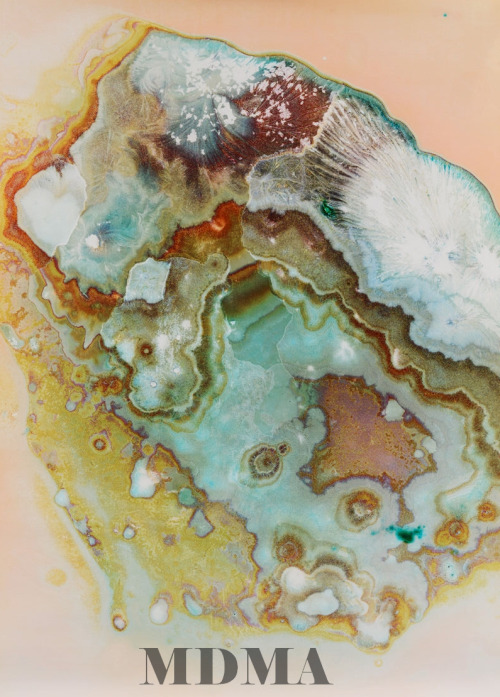


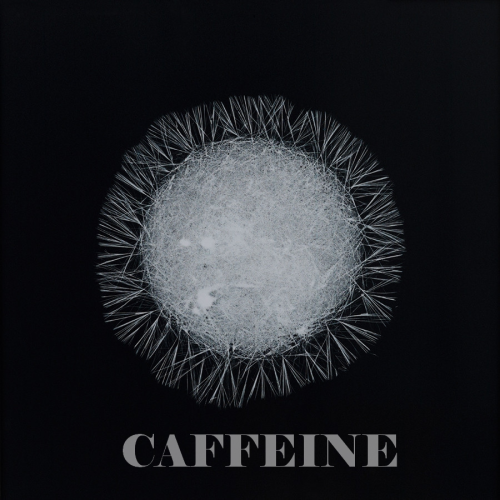


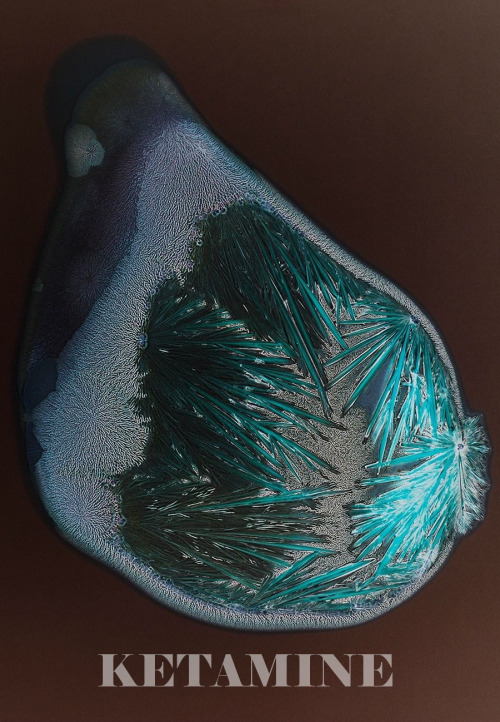

Drugs Under The Microscope
I Recently read About these amazing glow in the dark creatures in the newspapers and thought it was worth sharing 1. Saprobe Panellus Stipticus, Fungi:


Found in Asia, Australia, Europe and North America, the bio-luminescence emitted by the Saprobe fungi that grows on decaying wood...

KISS OF DEATH
One of the reasons cancer is so hard to defeat is that the body’s immune system has trouble recognizing cancer cells growing among healthy cells. Some scientists want to help. Researchers designed mouse T cells to specifically bind to a protein complex on fibrosarcoma MC57 tumor cell membranes. In this sped-up video, once the T cells (each about 10 μm across) meet their targets, they create holes in the cancer cell membranes using a protein called perforin. Next, the immune cells flood the pierced cells with a rush of cell-killing granules called granzymes. Propidium iodide, a dye the scientists added to the plate of cells, also squeezes in through the hole and starts glowing red when it comes in contact with RNA and DNA inside the cancer cells. This tells the researchers that the cells have been pierced and will soon die. This process takes about 75 minutes in real time.
Credit: Misty Jenkins (Read the paper.)
Related C&EN content:
The Immune System Fights Back
Cancer-Killing Machine
Using the Power of Space to Fight Cancer
From cancer research to DNA sequencing, the International Space Space is proving to be an ideal platform for medical research. But new techniques in fighting cancer are not confined to research on the space station. Increasingly, artificial intelligence is helping to “read” large datasets. And for the past 15 years, these big data techniques pioneered by our Jet Propulsion Laboratory have been revolutionizing biomedical research.
Microgravity Research on Space Station
On Earth, scientists have devised several laboratory methods to mimic normal cellular behavior, but none of them work exactly the way the body does. Beginning more than 40 years ago aboard Skylab and continuing today aboard the space station, we and our partners have conducted research in the microgravity of space. In this environment, in vitro cells arrange themselves into three-dimensional groupings, or aggregates. These aggregates more closely resemble what actually occurs in the human body. Cells in microgravity also tend to clump together more easily, and they experience reduced fluid shear stress – a type of turbulence that can affect their behavior. The development of 3D structure and enhanced cell differentiation seen in microgravity may help scientists study cell behavior and cancer development in models that behave more like tissues in the human body.

In addition, using the distinctive microgravity environment aboard the station, researchers are making further advancements in cancer therapy. The process of microencapsulation was investigated aboard the space station in an effort to improve the Earth-based technology. Microencapsulation is a technique that creates tiny, liquid-filled, biodegradable micro-balloons that can serve as delivery systems for various compounds, including specific combinations of concentrated anti-tumor drugs. For decades, scientists and clinicians have looked for the best ways to deliver these micro-balloons, or microcapsules, directly to specific treatment sites within a cancer patient, a process that has the potential to revolutionize cancer treatment.

A team of scientists at Johnson Space Center used the station as a tool to advance an Earth-based microencapsulation system, known as the Microencapsulation Electrostatic Processing System-II (MEPS-II), as a way to make more effective microcapsules. The team leveraged fluid behavior in microgravity to develop a new technique for making these microcapsules that would be more effective on Earth. In space, microgravity brought together two liquids incapable of mixing on Earth (80 percent water and 20 percent oil) in such a way that spontaneously caused liquid-filled microcapsules to form as spherical, tiny, liquid-filled bubbles surrounded by a thin, semipermeable, outer membrane. After studying these microcapsules on Earth, the team was able to develop a system to make more of the space-like microcapsules on Earth and are now performing activities leading to FDA approval for use in cancer treatment.

In addition, the ISS National Laboratory managed by the Center for the Advancement of Science in Space (CASIS) has also sponsored cancer-related investigations. An example of that is an investigation conducted by the commercial company Eli Lilly that seeks to crystallize a human membrane protein involved in several types of cancer together with a compound that could serve as a drug to treat those cancers.
“So many things change in 3-D, it’s mind-blowing – when you look at the function of the cell, how they present their proteins, how they activate genes, how they interact with other cells,” said Jeanne Becker, Ph.D., a cell biologist at Nano3D Biosciences in Houston and principal investigator for a study called Cellular Biotechnology Operations Support Systems: Evaluation of Ovarian Tumor Cell Growth and Gene Expression, also known as the CBOSS-1-Ovarian study. “The variable that you are most looking at here is gravity, and you can’t really take away gravity on Earth. You have to go where gravity is reduced."
Crunching Big Data Using Space Knowledge

Our Jet Propulsion Laboratory often deals with measurements from a variety of sensors – say, cameras and mass spectrometers that are on our spacecraft. Both can be used to study a star, planet or similar target object. But it takes special software to recognize that readings from very different instruments relate to one another.
There’s a similar problem in cancer research, where readings from different biomedical tests or instruments require correlation with one another. For that to happen, data have to be standardized, and algorithms must be “taught” to know what they’re looking for.
Because space exploration and cancer research share a similar challenge in that they both must analyze large datasets to find meaning, JPL and the National Cancer Institute renewed their research partnership to continue developing methods in data science that originated in space exploration and are now supporting new cancer discoveries.
JPL’s methods are leading to the development of a single, searchable network of cancer data that researcher can work into techniques for the early diagnosis of cancer or cancer risk. In the time they’ve worked together, the two organizations’ efforts have led to the discovery of six new Food and Drug Administration-approved cancer biomarkers. These agency-approved biomarkers have been used in more than 1 million patient diagnostic tests worldwide.
Make sure to follow us on Tumblr for your regular dose of space: http://nasa.tumblr.com


The Tsars’s vodka in action. Aqua regia or Царская водка in Russian is a 3/1 mixture of hydrochloric acid and nitric acid.
Upon mixing concentrated hydrochloric acid and concentrated nitric acid a chemical reactions occurs. The product of the reaction is nitrosyl chloride and chlorine as evidenced by the fuming nature and characteristic yellow color of aqua regia. In this case the dissolved copper and other transition metals turned the color of the solution deep green, but the gas over the solution is yellow from the chlorine and nitrous fumes.
Interesting fact about the Nobel prize and the dissolution of gold:
When Nazi Germany occupied Denmark from April 1940, during World War II, György de Hevesy dissolved the gold Nobel Prizes of Max von Laue and James Franck with aqua regia; it was illegal at the time to send gold out of the country, and were it discovered that Laue and Franck had done so to prevent them from being stolen, they could have faced prosecution in Germany. He placed the resulting solution on a shelf in his laboratory at the Niels Bohr Institute. After the war, he returned to find the solution undisturbed and precipitated the gold out of the acid. The Nobel Society then recast the Nobel Prizes using the original gold.
George de Hevesy got his Noble Prize in Chemistry for ”for his work on the use of isotopes as tracers in the study of chemical processes” in 1943.
Max von Laue got his Nobel Prize in Physics for ”for his discovery of the diffraction of X-rays by crystals” in 1914.
James Franck got his Nobel Prize in Physics ”for his discovery of the laws governing the impact of an electron upon an atom” in 1925.
And now, we shall pretend to be mathematicians.
Quantum mechanics lecturer on solving the Hermite equation (via mathprofessorquotes)




Next week I’ll give a presentation on the Researchers Night at Eötvös Loránd University, Hungary with the title: “Chemistry of light and the light of chemistry”.
During this presentation one of my favorite dyes will be also presented: Nile Red. However, just as usual, the 1000 USD/gram price was a bit over our budget, so I had to make it.
The raw product was contaminated with a few impurities, but a fast purification, by simple filtering the mixture through a short column helped a lot and ended up with a +95% pure product.
At first I concentrated the product from a dilute solution on the column as seen on the first pics. It’s interesting to see, that it has a different fluorescence in solution (faint orange fluorescent) and while it’s absorbed on the solid phase (pink, highly fluorescent).
After all the product was on the solid phase, I added another solvent and washed down the pure, HIGHLY FLUORESCENT product. Everything else, what was mainly products of side reactions, stuck at the top of the column as seen on the second pics and the gifs.
Also here is a video from the whole process in HD: https://youtu.be/W0Lk5jkd_B0
-
 birdmanjo liked this · 1 year ago
birdmanjo liked this · 1 year ago -
 significantlylesschill liked this · 1 year ago
significantlylesschill liked this · 1 year ago -
 homebrewstims reblogged this · 1 year ago
homebrewstims reblogged this · 1 year ago -
 atomicstarburstlabware reblogged this · 1 year ago
atomicstarburstlabware reblogged this · 1 year ago -
 grysi liked this · 1 year ago
grysi liked this · 1 year ago -
 sacerdito liked this · 4 years ago
sacerdito liked this · 4 years ago -
 ewasteorpheus reblogged this · 5 years ago
ewasteorpheus reblogged this · 5 years ago -
 cybergee reblogged this · 5 years ago
cybergee reblogged this · 5 years ago -
 cybergee liked this · 5 years ago
cybergee liked this · 5 years ago -
 zanyeggartisanhoagie liked this · 5 years ago
zanyeggartisanhoagie liked this · 5 years ago -
 freshleys-blog liked this · 6 years ago
freshleys-blog liked this · 6 years ago -
 tugteno liked this · 6 years ago
tugteno liked this · 6 years ago -
 baastard reblogged this · 6 years ago
baastard reblogged this · 6 years ago -
 kikakikirika reblogged this · 6 years ago
kikakikirika reblogged this · 6 years ago -
 ash-moztaza liked this · 7 years ago
ash-moztaza liked this · 7 years ago -
 turn0nthedarkness liked this · 7 years ago
turn0nthedarkness liked this · 7 years ago -
 bvand77 liked this · 7 years ago
bvand77 liked this · 7 years ago -
 tthomusic liked this · 7 years ago
tthomusic liked this · 7 years ago -
 mrscactoos liked this · 7 years ago
mrscactoos liked this · 7 years ago -
 chemistofart liked this · 7 years ago
chemistofart liked this · 7 years ago -
 aaa31 liked this · 7 years ago
aaa31 liked this · 7 years ago -
 plum996 liked this · 7 years ago
plum996 liked this · 7 years ago -
 slowlydescendingintoinsanity liked this · 7 years ago
slowlydescendingintoinsanity liked this · 7 years ago -
 thechameleonlover liked this · 7 years ago
thechameleonlover liked this · 7 years ago -
 perlaamedina reblogged this · 7 years ago
perlaamedina reblogged this · 7 years ago -
 robdeath liked this · 7 years ago
robdeath liked this · 7 years ago -
 catsarepositive reblogged this · 7 years ago
catsarepositive reblogged this · 7 years ago -
 clairdelunascent reblogged this · 8 years ago
clairdelunascent reblogged this · 8 years ago -
 clairdelunascent liked this · 8 years ago
clairdelunascent liked this · 8 years ago -
 shadowphoniex1000 liked this · 8 years ago
shadowphoniex1000 liked this · 8 years ago -
 tineyandrowan liked this · 8 years ago
tineyandrowan liked this · 8 years ago -
 tineyandrowan reblogged this · 8 years ago
tineyandrowan reblogged this · 8 years ago -
 jsisawesome liked this · 8 years ago
jsisawesome liked this · 8 years ago -
 copernikush reblogged this · 8 years ago
copernikush reblogged this · 8 years ago -
 purpledream-5h-af liked this · 8 years ago
purpledream-5h-af liked this · 8 years ago -
 lizzibennet reblogged this · 8 years ago
lizzibennet reblogged this · 8 years ago -
 lizzibennet liked this · 8 years ago
lizzibennet liked this · 8 years ago -
 spoonfullofspock reblogged this · 8 years ago
spoonfullofspock reblogged this · 8 years ago -
 m-caesarcrown-blog liked this · 8 years ago
m-caesarcrown-blog liked this · 8 years ago -
 generalwow liked this · 8 years ago
generalwow liked this · 8 years ago -
 angelwhoangelyou54 reblogged this · 8 years ago
angelwhoangelyou54 reblogged this · 8 years ago -
 mysticalmusicalchaos reblogged this · 8 years ago
mysticalmusicalchaos reblogged this · 8 years ago -
 fannerl reblogged this · 8 years ago
fannerl reblogged this · 8 years ago
60 posts